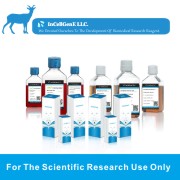

| Organism | Homo sapiens, human |
|---|---|
| Tissue | colon |
| Cell Type | epithelial |
| Product Format | frozen |
| Morphology | epithelial |
| Culture Properties | adherent |
| Biosafety Level |
1
Biosafety classification is based on U.S. Public Health Service Guidelines, it is the responsibility of the customer to ensure that their facilities comply with biosafety regulations for their own country. |
| Disease | Dukes'' type C, colorectal adenocarcinoma |
| Age | adult |
| Gender | male |
| Applications |
This cell line is a suitable transfection host.
|
| Storage Conditions | liquid nitrogen vapor phase |
| Karyotype | This is a pseudodiploid human cell line with the modal chromosome number of 46, occurring in 86% of cells. The rate of polyploidy was high at 17.1%. The karyotype of the line was 46,XY,-2,+dir dup(2)(p13-p23). The Y chromosome was slightly longer than N22 and had a large segment of heterochromatic, fluorescent distal q arms. |
|---|---|
| Derivation |
DLD-1 is one of two colorectal adenocarcinoma cell lines which were isolated by D.L. Dexter and associates during a period from 1977-1979
|
| Clinical Data |
male
|
| Antigen Expression |
Blood type O. The cells are weakly positive for keratins and vimentin. The cells are positive for keratin by immunoperoxidase staining. DLD-1 cells are positive for p53 antigen expression (the p53 antigen produced has a C -> T mutation resulting in Ser -> Phe at position 241). |
| Oncogene | myc +; myb + ; ras +; fos +; sis +; p53 +; abl -; ros -; src - |
| Genes Expressed |
carcinoembryonic antigen (CEA) 0.5 ng/106 cells/10 days; colon antigen 3. |
| Cellular Products |
carcinoembryonic antigen (CEA) 0.5 ng/10 exp6 cells/10 days; colon antigen 3; keratin
|
| Tumorigenic | Yes |
| Effects |
Yes, in nude mice
(Tumors developed within 21 days at 100% frequency (5/5) in nude mice inoculated subcutaneously with 10(7) cells)
|
| Comments |
This cell line is one of four colorectal adenocarcinoma cell lines that have been identified as being derived from a single individual. DNA profiling studies [1,2] have shown that DLD-1 (ATCC CCL-221), HCT-15 (ATCC CCL-225), HCT-8 (ATCC CCL-244) and HRT-18G (ATCC CRL-11663) share a single profile. DNA fingerprinting and cytogenetic analyses performed at ATCC and elsewhere show the line is similar to HCT-15 (CCL-225) and suggest the two are of different clonal origin from the same individual.
Their genetic origin has been confirmed by DNA fingerprinting; however, cytogenetic analysis has shown that they lack concurrent marker chromosomes or concurrent numerical changes.
A culture of unknown passage submitted to the ATCC in 1979 was found to be contaminated with Mycoplasma hyorhinis. The cells were subsequently cured using a combination of antibiotics over a 12-week cultivation period.
Following treatment, the cells were assayed by the Hoechst stain weekly and by the standard culture test periodically. During 11 consecutive months of cultivation in the absence of antibiotics, all of these tests were negative.
|
Subculturing
Volumes used in this protocol are for 75 cm2 flask; proportionally reduce or increase amount of dissociation medium for culture vessels of other sizes.
- Remove and discard culture medium.
- Briefly rinse the cell layer with 0.25% (w/v) Trypsin-0.53mM EDTA solution to remove all traces of serum, which contains trypsin inhibitor.
- Add 2.0 to 3.0 mL of Trypsin-EDTA solution to flask and observe cells under an inverted microscope until cell layer is dispersed (usually within 5 to 15 minutes). Note: To avoid clumping do not agitate the cells by hitting or shaking the flask while waiting for the cells to detach. Cells that are difficult to detach may be placed at 37��C to facilitate dispersal.
- Add 6.0 to 8.0 mL of complete growth medium and aspirate cells by gently pipetting.
- Add appropriate aliquots of the cell supension to new culture vessels.
- Incubate cultures at 37��C.


